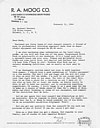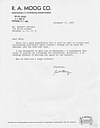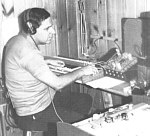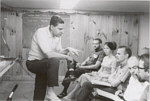MoogArchives:
Your meetings with Bob Moog in 1964 resulted in the development of the first Moog synthesizer. When was the first meeting, how did it come about and what do you remember about it?
|
Herb Deutsch:

 The first actual meeting took place in November 1963 at a NY State School Music Assn. Allstate conference at the Eastman School in Rochester. Bob was there selling theremins and theremin kits and when I told him that I had assembled a Melodia he and I began talking about the future of electronic instruments and I invited him to an electronic music concert being planned for February 1964 in sculptor Jason Seley's NY studio.
The first actual meeting took place in November 1963 at a NY State School Music Assn. Allstate conference at the Eastman School in Rochester. Bob was there selling theremins and theremin kits and when I told him that I had assembled a Melodia he and I began talking about the future of electronic instruments and I invited him to an electronic music concert being planned for February 1964 in sculptor Jason Seley's NY studio.
|
|
Do you recall any interesting stories from those meetings? Where were they held?
|
|
Too many to put down. The first meeting lasted at least three hours in Rochester. After my February concert, Bob and I (with wives) went out to eat and talked about the possibility of a "small and affordable music synthesizer"
|
|
Are there any surviving tape recordings of your and Bob's experiments?
|
|
Yes. The most interesting thing is a tape Bob sent to me in August 64 describing and playing what was to become the prototype. In the Fall of 64 on the prototype he shipped, I wrote "Jazz Images, a Worksong and Blues" which was the first piece ever to use the Moog Synthesizer.
|
|
At the time you must have known you were onto something big. Did you have any idea how significant your work really was, or how it might impact the future of music?
|
 At the time I was actually still thinking primarily as a composer and at first we were probably more interested in the potential expansion of the musical aural universe than we were of its effect upon the broader musical community. In fact when Bob questioned me on whether the instrument should have a regular keyboard (Vladimir Ussachevsky had suggested to him that it should not) I told Bob "I think a keyboard is a good idea, after all, having a piano did not stop Schoenberg from developing twelve-tone music and putting a keyboard on the synthesizer would certainly make it a more sale-able product!!"
At the time I was actually still thinking primarily as a composer and at first we were probably more interested in the potential expansion of the musical aural universe than we were of its effect upon the broader musical community. In fact when Bob questioned me on whether the instrument should have a regular keyboard (Vladimir Ussachevsky had suggested to him that it should not) I told Bob "I think a keyboard is a good idea, after all, having a piano did not stop Schoenberg from developing twelve-tone music and putting a keyboard on the synthesizer would certainly make it a more sale-able product!!"
|
|
Had Bob already developed the concept of voltage control before you met, or did that result from your collaboration?
|
|
Bob's first breadboard proto (summer of '64) had voltage control, and he explained it to me, so it was already a concept, though perhaps not yet applied to a musical instrument.
|
|
Regarding electronic music instrumentation, and Moog synthesizers in particular, can you speculate on how differently things might have developed if your collaboration with Bob hadn't happened?
|
|
People have accused me of modesty, but actually I think that someone else would have been in the same place and gotten to a similar point within a short time. It was a direction that fit into the history of technology and its inevitable link with the arts.
|
|
Several composers gathered in Trumansburg in the summer of 1965. The meeting
culminated in an afternoon concert at the Moog plant on August 28. Other than the concert program, there doesn't seem to be any surviving information about this event. Can you describe it? How was it received?
|
 I should have a recording of that concert. It was played for a very small audience, primarily the families and friends of the 12 participants. My own piece, "A Little Night Music, The Ithaca Journal, August 6, 1965" was released in 1990 on a cassette recording called "From Moog to Mac" and will be part of a retrospective CD to be shortly available.
I should have a recording of that concert. It was played for a very small audience, primarily the families and friends of the 12 participants. My own piece, "A Little Night Music, The Ithaca Journal, August 6, 1965" was released in 1990 on a cassette recording called "From Moog to Mac" and will be part of a retrospective CD to be shortly available.
|
|
You performed in the historic "Jazz in the Garden" concert at the Museum of Modern Art, in 1969. What do you remember about that concert?
|
|
That was a most unusual event. Bob designed and assembled four modular
systems. One was a rather typical simple system used primarily for bass
sounds and voices, a second was much more complex, and assembled to
allow a soloist to access a wide variety of voices with fast selection
by both patching and flipping switches...that was the primary
synthersizer. A third and very interesting unit was one designed to
provide many different percussion, cymbal and drum sounds playable, of
course, from a keyboard. The fourth was actually a hybrid of Moog
modules with a polyphonic keyboard which allowed the pianist of the
group (Hank Jones was the wonderful player in my quartet) to play solos
as well as "comp" behind other soloists.
When putting together my quartet, I first called Herbie Hancock asking him to play the polyphonic synth at the MOMA concert. I don't remember his exact words, but he felt that at the time, synthesizers and electronic music were things he didn't know enough
about (pretty amazing considering where he went within 4 years of that concert!!). It was Herbie who suggested that Hank Jones might be interested, and it was really an honor to get to know Hank. He (one of the famous "Jones Boys") then went on to appear as a soloist with my Hofstra Jazz Ensemble a couple of years later.
Jazz in the Garden was amazing for many reasons: 1) the instruments
were not completed until two days prior to the concert, so rehearsals
were VERY limited. 2) The event was incredibly crowded and quite
thrilling (with the air filled with the smoke of hundreds of joints). 3)
The close of the concert, which is very well-documented, was dramatic,
because someone stepped on a power cord, pulling the entire ensemble
into silence - - - which the excited audience considered part of the
show and screamed their approval.
|
|
More to come...
|

 The first actual meeting took place in November 1963 at a NY State School Music Assn. Allstate conference at the Eastman School in Rochester. Bob was there selling theremins and theremin kits and when I told him that I had assembled a Melodia he and I began talking about the future of electronic instruments and I invited him to an electronic music concert being planned for February 1964 in sculptor Jason Seley's NY studio.
The first actual meeting took place in November 1963 at a NY State School Music Assn. Allstate conference at the Eastman School in Rochester. Bob was there selling theremins and theremin kits and when I told him that I had assembled a Melodia he and I began talking about the future of electronic instruments and I invited him to an electronic music concert being planned for February 1964 in sculptor Jason Seley's NY studio.
 At the time I was actually still thinking primarily as a composer and at first we were probably more interested in the potential expansion of the musical aural universe than we were of its effect upon the broader musical community. In fact when Bob questioned me on whether the instrument should have a regular keyboard (Vladimir Ussachevsky had suggested to him that it should not) I told Bob "I think a keyboard is a good idea, after all, having a piano did not stop Schoenberg from developing twelve-tone music and putting a keyboard on the synthesizer would certainly make it a more sale-able product!!"
At the time I was actually still thinking primarily as a composer and at first we were probably more interested in the potential expansion of the musical aural universe than we were of its effect upon the broader musical community. In fact when Bob questioned me on whether the instrument should have a regular keyboard (Vladimir Ussachevsky had suggested to him that it should not) I told Bob "I think a keyboard is a good idea, after all, having a piano did not stop Schoenberg from developing twelve-tone music and putting a keyboard on the synthesizer would certainly make it a more sale-able product!!"
 I should have a recording of that concert. It was played for a very small audience, primarily the families and friends of the 12 participants. My own piece, "A Little Night Music, The Ithaca Journal, August 6, 1965" was released in 1990 on a cassette recording called "From Moog to Mac" and will be part of a retrospective CD to be shortly available.
I should have a recording of that concert. It was played for a very small audience, primarily the families and friends of the 12 participants. My own piece, "A Little Night Music, The Ithaca Journal, August 6, 1965" was released in 1990 on a cassette recording called "From Moog to Mac" and will be part of a retrospective CD to be shortly available.